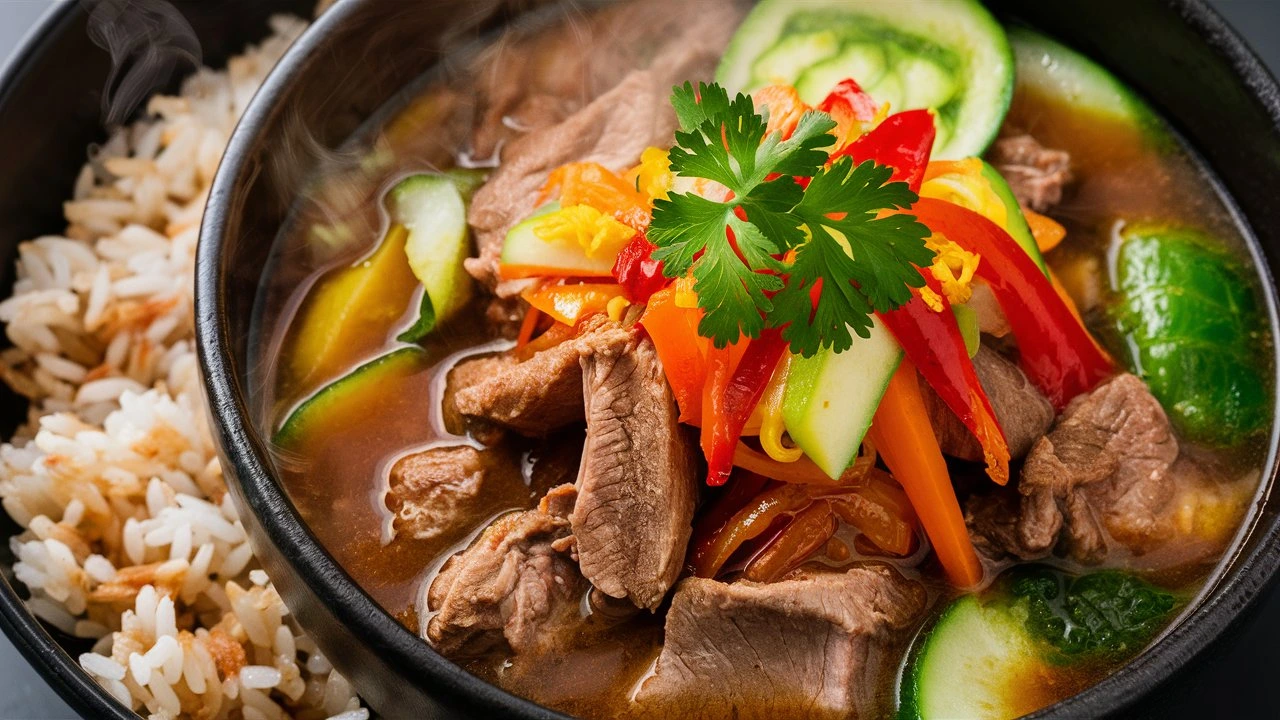The Best Beef Sinigang Recipe You’ll Ever Try

Table of Contents
Introduction to Beef Sinigang recipe 🌧️
What Is Sinigang?
Ever had a dish that hugs your soul while making your lips pucker? That’s sinigang for you! This iconic Filipino stew is loved for its bold sourness and comforting warmth. Traditionally made with pork, shrimp, or fish, sinigang has evolved to include the hearty and deeply flavorful beef sinigang recipe—a variation that packs a punch and keeps you coming back for seconds (and thirds!).
It’s not just soup—it’s a Filipino comfort ritual. Whether you’re sitting at a table with family or missing the flavors of home, a bowl of sinigang can bring you there instantly. 🥄
Why This Recipe Is a Comfort Food Classic
So, why beef? Good question. While pork sinigang is the go-to in many households, using beef—especially beef shank or short ribs—brings a richness that can’t be beat. The long simmer time draws out deep, meaty flavors that meld beautifully with the sour broth. Plus, that fall-off-the-bone tenderness? Unreal.
Imagine this: it’s raining, you’ve got rice on your plate, and your spoon dives into a bowl of steaming hot beef sinigang. That’s a whole vibe. ☁️🍚
What Makes This Beef Sinigang Recipe Special?
Unlike many sinigang recipes that rely heavily on store-bought soup bases, this version is all about balancing tradition with accessibility. We’ll show you how to make it the classic way, with room for customization—whether you’re a beginner or a seasoned home cook.
What’s in it for you?
- Simple instructions even if you’ve never cooked Filipino food before.
- Easily sourced sinigang ingredients you can find in most grocery stores.
- Pro tips for getting the perfect sinigang broth without it being too sour or bland.
Why You’ll Love This Beef Sinigang Recipe ❤️
Perfect Balance of Tangy and Savory Flavors
The magic of sinigang lies in contrast. That lip-smacking tang from tamarind (or a mix if you’re using a packet) plays beautifully with the natural umami from beef and vegetables. It’s like a flavor roller coaster—sour, savory, slightly sweet, and super satisfying.
You’re not just tasting this dish, you’re feeling it—like a warm, flavorful hug.
Hearty and Nutritious Ingredients
Let’s be real: this isn’t just delicious, it’s packed with nutrients. From daikon radish and eggplant to kangkong (water spinach), you’re getting a medley of fiber, vitamins, and minerals.
And the beef? It’s loaded with protein, iron, and flavor. Whether you’re cooking for your family, meal-prepping, or just treating yourself, you’re doing your body a favor. 🥬🥩
Great for Rainy Days or Cozy Nights
Few dishes scream “rainy day essential” louder than sinigang. Whether it’s stormy outside or you’re just curled up with a Netflix marathon, a hot bowl of This Recipe with rice makes everything feel just right.
Bonus: it stores well and tastes even better the next day. The kind of dish you’ll look forward to reheating.
This Recipe is a dish full of deep, refreshing flavors that everyone loves. If you’re a fan of sinigang, you might also enjoy trying the Chicken Sinigang recipe, which is a great alternative for those who prefer chicken over beef. Authentic Filipino Chicken Sinigang Recipe
Ingredients Breakdown 🧂🍅
Let’s dive into what you’ll actually need to whip this baby up.
Core Ingredients You’ll Need
| Ingredient | Purpose |
|---|---|
| Beef shank | Adds deep, meaty flavor and richness |
| Tamarind base | The star souring agent (fresh, paste, or mix) |
| Tomatoes | Add acidity and body to the broth |
| Onion | Sweetens and rounds out the flavor |
| Water spinach | A Filipino staple, adds freshness and bite |
| Radish (Labanos) | Crunchy texture and mild bitterness |
| Eggplant | Absorbs flavor like a sponge |
| Green beans | Adds crunch and color |
| Fish sauce | Brings that funky umami depth |
| Salt & pepper | Basic seasoning, because yes, you need both! |
These sinigang ingredients form the base of our traditional stew. You can adjust based on what’s in season or what your family prefers.
Optional Add-Ins for Extra Flavor
Want to jazz it up a bit?
- Corn on the cob – Adds sweetness to contrast the sour broth 🌽
- Green chili – For a spicy twist 🌶️
- Okra – Another traditional veg that adds a unique texture
- Sweet potato – Great for thickening and adding depth
Best Cuts of Beef for Sinigang
Hands down, the beef shank (with bone marrow) is top-tier for sinigang. It’s flavorful, gets ultra-tender with slow cooking, and adds a gelatinous richness to the broth.
Other good options:
- Short ribs – Meaty and indulgent
- Beef brisket – Great if you’re feeding a crowd
- Oxtail – Adds collagen and deep beef flavor
Avoid lean cuts like sirloin—they tend to dry out and don’t add much flavor.
Where to Buy Filipino Sinigang Ingredients
If you’re not in the Philippines, don’t worry! Most Asian grocery stores carry:
- Knorr or Mama Sita’s sinigang mix
- Fresh kangkong or substitute with spinach
- Tamarind paste or concentrate
For online shoppers, Amazon or Asian food stores like Seafood City, H Mart, or 99 Ranch are great options.
Kitchen Tools You’ll Need 🔪🍳
You don’t need a fancy kitchen to make great sinigang. But a few essentials help a lot.
Must-Have Cooking Equipment
| Tool | Why You Need It |
|---|---|
| Large stockpot | For boiling beef and simmering all the ingredients |
| Chef’s knife | For slicing meat and chopping veggies |
| Cutting board | Protect your counters while prepping |
| Ladle | Makes serving the broth so much easier |
Useful Add-Ons (Optional Tools for Convenience)
- Skimmer or slotted spoon – Helps remove impurities or scum while boiling beef
- Soup strainer – If you want ultra-clear broth
- Instant pot or pressure cooker – Cuts cooking time in half ⏱️
Tips on Prepping Tools Efficiently
- Chop all your veggies while the beef is boiling—this saves time ⏳
- Use separate boards for meat and vegetables to avoid cross-contamination
- Keep a clean kitchen towel nearby—you’ll thank yourself later
How to Cook Beef Sinigang recipe – Step-by-Step Instructions 🧑🍳
Ready to turn those ingredients into pure comfort in a bowl? Let’s walk through it together.
Step 1 – Prep Your Ingredients Like a Pro
Before anything hits the pot, it’s all about mise en place (a fancy French term meaning “everything in its place”). Trust me—it makes cooking smoother.

- Wash and slice your vegetables.
- Cut your beef into large chunks if not pre-cut.
- Rinse your beef thoroughly under cold water.
💡 Pro tip: Soak the beef in cold water for 10–15 minutes, then discard the water. This helps remove excess blood and results in a cleaner, clearer broth.
Step 2 – Simmer the Beef Until It’s Fork-Tender
- Place the beef in a large stockpot and cover with water.
- Bring to a boil over medium-high heat.
- Skim off the scum that rises to the top (yes, that foam stuff—get rid of it!).
Once it’s cleared up:
- Add chopped onions and tomatoes.
- Lower the heat and simmer for 1.5 to 2 hours until the beef becomes fall-apart tender. If you’re using a pressure cooker, it’ll only take about 30–40 minutes!
🍖 Flavor hack: Add a tablespoon of fish sauce while it simmers. That savory base builds up flavor from the get-go.
Step 3 – Add Tamarind Base or Sinigang Mix
Once your beef is nice and tender, it’s time to bring that signature sour punch!
Options:
- Fresh tamarind: Simmer about 1 cup in a separate pot, mash it, then strain the juice into the broth.
- Tamarind paste or concentrate: Use 1–2 tablespoons depending on your sour preference.
- Sinigang mix (like Knorr or Mama Sita’s): Super convenient and very flavorful. Add 1 packet first, then taste-test.
Stir everything well and let it simmer another 5 minutes.
Step 4 – Add Vegetables in Order of Cooking Time 🥬🍆
Vegetables cook at different rates, so don’t just toss them all in at once.

Add in this order:
- Radish and eggplant – simmer for 5–7 minutes.
- Green beans and okra (if using) – simmer another 3–5 minutes.
- Water spinach or kangkong – toss in at the very end, just 1–2 minutes before turning off the heat.
You want veggies tender but not mushy.
Step 5 – Season and Adjust
Taste test time!
- Add fish sauce, salt, or pepper as needed.
- Prefer it more sour? Stir in more tamarind or half a packet of sinigang mix.
- Want some heat? Toss in a sliced green chili. 🔥
Expert Tips to Make the Perfect Beef Sinigang recipe 🧠
Choose the Right Cut of Beef
Tougher cuts like shank or brisket are your friends. They need longer cooking, yes, but reward you with rich flavor and melt-in-your-mouth texture.
💡 Avoid lean cuts! They might turn rubbery and dry during the simmer.
Let the Broth Do the Talking
Don’t drown your sinigang in seasoning. The beauty of this dish is in its natural beefy-tamarind balance. Let those layers of flavor build slowly. Like a song, the best part is the crescendo!
Use Fresh Tamarind If Possible
If you have access to fresh tamarind pods, try them! They give the broth a more rounded, mellow tang that mixes beautifully with the beef’s umami.
But hey—if all you have is a packet? No shame at all. This is about comfort and convenience.
How to Serve Beef Sinigang recipe Like a True Filipino 🍽️🇵🇭
Serve with Steamed White Rice
It’s a non-negotiable. That flavorful broth seeps into the rice, and every bite becomes a perfect combo of tangy, meaty, and starchy. You’ll probably want a second helping of rice (maybe third… who’s counting?).

Add Condiments on the Side
Filipino-style eating always comes with a few fun sidekicks:
- Fish sauce with calamansi or lemon juice
- Chili garlic oil for heat
- Bagoong (fermented shrimp paste) for the brave 💪
Make It a Meal with Side Dishes
Pair your sinigang with:
- Fried tilapia or bangus
- Lumpiang shanghai (Filipino spring rolls)
- Fresh mango with bagoong for that sweet/salty contrast
Storing and Reheating Leftover Sinigang 🧊🔥
How to Store It Properly
Cool completely before storing. Place leftovers in an airtight container and refrigerate for up to 3–4 days. The flavors will deepen overnight!
Best Way to Reheat Sinigang
Reheat gently on the stovetop over medium heat. Add a splash of water or broth if it’s too thick. Microwaving works too—just cover it with a lid or plastic wrap to prevent splatters.
🍲 Heads up: Water spinach gets soggy on day two. Remove and replace with fresh greens if you’re picky about texture.
Frequently Asked Questions ❓
Can I make This Recipe in a slow cooker?
Absolutely! Toss everything (except delicate greens) into your slow cooker. Cook on low for 6–8 hours, add greens at the end, and boom—lazy-day sinigang.
Is there a keto version of This Recipe?
Yes! Just skip starchy veggies like potatoes or corn. Stick to eggplant, spinach, and radish. Serve it as a soup instead of with rice.
What if I can’t find tamarind or sinigang mix?
You can use a mix of:
- Lemon juice or calamansi
- A touch of vinegar
- Tomatoes
It’s not traditional, but it still gives that iconic sour punch.
Conclusion – This Recipe Is Love in a Bowl 💖🍜
Beef sinigang isn’t just a meal—it’s a memory. It’s Sunday lunches, rainy afternoons, and family gatherings all in one pot. Whether you’re new to Filipino cooking or grew up with this dish, this beef sinigang recipe is a guaranteed crowd-pleaser.
So grab a bowl, scoop some rice, and ladle in that glorious broth. Sour, savory, steamy, and oh-so-satisfying—this is the kind of dish that tastes like home, no matter where you are.
Review Our Recipe: Your Feedback Makes a Difference
There are no reviews yet. Be the first one to write one.
